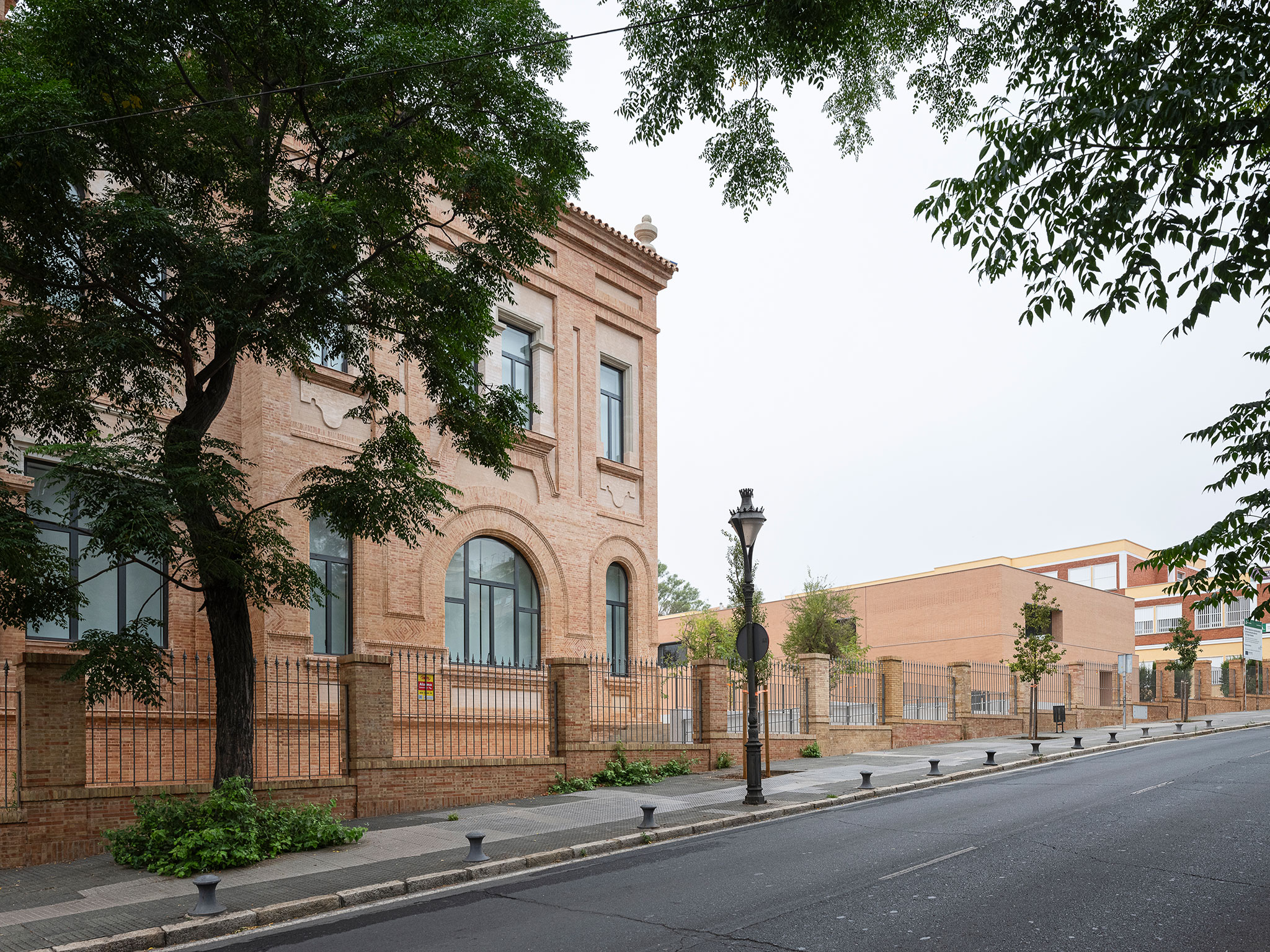
The intervention, by Francisco Marqués Vilaplana and Luis Rubio Marín, is a search for resilience through dialogue with the past, proposing a heterogeneous program with the central courtyard as an element around which the classrooms are organized. The new volume generates access and a staircase linked to the central courtyard, allowing light and ventilation to be introduced into a section of the gallery that until now was residual.
In addition, the new gymnasium helps to organize the exterior spaces, establishing a dialogue with the imposing existing building while claiming autonomy from the contemporaneity of its language. The brickwork of the façade, the mouldings of the pillars, the natural stone and the terrazzo expose the idea of renovating the building while maintaining respect for its history.

La Rábida Institute Renovation by Francisco Marqués Vilaplana and Luis Rubio Marín. Photograph by Fernando Alda.
Project description by Francisco Marqués Vilaplana and Luis Rubio Marín
The La Rábida Institute (1932), designed by architect José María Pérez Carasa, has been subjected to a long list of partial, unconnected reforms since its inception, which have led to the loss of clarity and coherence of its internal structure. To reverse this situation, the project interprets from a present time those typological and spatial attributes that characterized its original layout, avoiding in the process both a stratigraphic reading of the new intervention and mimetic, anachronistic approximations.
The building is composed of a series of juxtaposed volumes —which vary depending on the program they were intended to house— arranged around a powerful axis of symmetry. In its original state, this fact resulted in a clear spatial differentiation between the strictly educational use, facing the large interior courtyard, and those of a more public nature (main hall, auditorium, chapel, library and administration), concentrated in the head. Subsequent interventions would deviate from this logic, making the functioning of the centre increasingly confusing, so one of the first project decisions will be to recover the coherence between spatial and functional structure.

Another fundamental issue has been to improve the relationship between the classroom building and the outside spaces. The intervention carried out in the seventies blocked the gallery and blocked the existing exit, forcing long and tortuous routes to access the playground. In response to this situation, two complementary operations are proposed: to generate an access in the extension building and to build a new staircase in front of it (in the volume previously occupied by the toilets) linked to the central courtyard. This action also allows light and ventilation to be introduced into a section of the gallery that until now was residual, reinforcing its continuity.
The high degree of deterioration of the central courtyard, the backbone of the classroom building, meant that it was no longer used as a recreational area for students. Its recovery is proposed as an opportunity to expand its possibilities of use, making it entirely passable and incorporating a fountain-bench in the most densely wooded area. On the other hand, there is evidence to suggest that the perimeter gallery was not originally closed, which has led to reducing the presence of the new carpentry to a minimum in order to enhance its cloister-like condition, an intermediate space between the garden and the classrooms. Ventilation is resolved by means of a system of slats in the upper area, thus allowing the vegetation and the fountain to collaborate in controlling the humidity and temperature conditions inside.

The semi-basement floor, labyrinthine and dark, was the result of numerous partial interventions developed over the years. The new layout reorganizes it completely, insisting on the axial layout of the rest of the floors. The two side entrances (Siurot and Terrades) are connected through an internal street, resolving the difference in height between the two by means of gentle ramps. In this way, the permeability and accessibility of the building is guaranteed.
The building to be renovated, with a constructed area of approximately 7,500 sqm, houses a heterogeneous programme that must adapt as naturally as possible to countless spatial and constructive singularities. To prevent the intervention from becoming a succession of unconnected episodes, we defined a clear constructive syntax: once a reduced palette of materials has been established, a series of rules are set that determine how to articulate the encounter between the different elements, which allows us to respond to diverse (and unforeseen) situations in a specific way within a relationship of continuity. This choice is dictated both by the need to meet environmental and functional requirements (resistance, maintenance, luminosity, acoustics, etc.) in a pragmatic way, and by the desire to make the renovated interior resonate with the material memory of the building: with the templated bricks of the façade, the mouldings of the pillars, the natural stone and terrazzo, as well as the imposing trees in the courtyard.

The new gymnasium helps to organise the exterior spaces, acting as a link between the IES la Rábida, the neighbouring IES Diego Guzmán de Quesada, and the different areas of the playground. The material and compositional solution of the façades establishes a dialogue with the existing building while claiming autonomy from the contemporaneity of its language.
The layout of the new urbanization recognizes the axis that articulates the institute, using curved geometries (a compositional resource present in various episodes of the building: flowerbeds in the main courtyard, stairs, tower) to enhance the continuity between interior and exterior, between old and new. In this way, it is also possible to link the various areas that make up the garden, providing the whole with a cohesion that it lacked until now.
































































